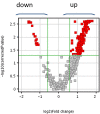Xylella fastidiosa subsp. pauca and olive produced lipids moderate the switch adhesive versus non-adhesive state and viceversa
- PMID: 32413086
- PMCID: PMC7228078
- DOI: 10.1371/journal.pone.0233013
Xylella fastidiosa subsp. pauca and olive produced lipids moderate the switch adhesive versus non-adhesive state and viceversa
Abstract
Global trade and climate change are re-shaping the distribution map of pandemic pathogens. One major emerging concern is Xylella fastidiosa, a tropical bacterium recently introduced into Europe from America. In last decades, X. fastidiosa was detected in several European countries. X. fastidiosa is an insect vector-transmitted bacterial plant pathogen associated with severe diseases in a wide range of hosts. X. fastidiosa through a tight coordination of the adherent biofilm and the planktonic states, invades the host systemically. The planktonic phase is correlated to low cell density and vessel colonization. Increase in cell density triggers a quorum sensing system based on mixture of cis 2-enoic fatty acids-diffusible signalling factors (DSF) that promote stickiness and biofilm. The lipidome profile of Olea europaea L. (cv. Ogliarola salentina) samples, collected in groves located in infected zones and uninfected zones was performed. The untargeted analysis of the lipid profiles of Olive Quick Decline Syndrome (OQDS) positive (+) and negative (-) plants showed a clustering of OQDS+ plants apart from OQDS-. The targeted lipids profile of plants OQDS+ and OQDS- identified a shortlist of 10 lipids that increase their amount in OQDS+ and X. fastidiosa positive olive trees. These lipid entities, provided to X. fastidiosa subsp. pauca pure culture, impact on the dual phase, e.g. planktonic ↔ biofilm. This study provides novel insights on OQDS lipid hallmarks and on molecules that might modulate biofilm phase in X. fastidiosa subsp. pauca.
Conflict of interest statement
The authors have declared that no competing interests exist.
Figures




Similar articles
-
Xylella fastidiosa: an examination of a re-emerging plant pathogen.Mol Plant Pathol. 2018 Apr;19(4):786-800. doi: 10.1111/mpp.12585. Epub 2017 Oct 24. Mol Plant Pathol. 2018. PMID: 28742234 Free PMC article.
-
Transcriptome profiling of two olive cultivars in response to infection by the CoDiRO strain of Xylella fastidiosa subsp. pauca.BMC Genomics. 2016 Jun 27;17:475. doi: 10.1186/s12864-016-2833-9. BMC Genomics. 2016. PMID: 27350531 Free PMC article.
-
Isolation and pathogenicity of Xylella fastidiosa associated to the olive quick decline syndrome in southern Italy.Sci Rep. 2017 Dec 18;7(1):17723. doi: 10.1038/s41598-017-17957-z. Sci Rep. 2017. PMID: 29255232 Free PMC article.
-
Xylella fastidiosa: Insights into an Emerging Plant Pathogen.Annu Rev Phytopathol. 2018 Aug 25;56:181-202. doi: 10.1146/annurev-phyto-080417-045849. Epub 2018 Jun 11. Annu Rev Phytopathol. 2018. PMID: 29889627 Review.
-
Thidiazuron: New Trends and Future Perspectives to Fight Xylella fastidiosa in Olive Trees.Antibiotics (Basel). 2022 Jul 14;11(7):947. doi: 10.3390/antibiotics11070947. Antibiotics (Basel). 2022. PMID: 35884201 Free PMC article. Review.
Cited by
-
Grapevine phenolic compounds influence cell surface adhesion of Xylella fastidiosa and bind to lipopolysaccharide.PLoS One. 2020 Oct 2;15(10):e0240101. doi: 10.1371/journal.pone.0240101. eCollection 2020. PLoS One. 2020. PMID: 33007036 Free PMC article.
-
Antimicrobial Peptides With Antibiofilm Activity Against Xylella fastidiosa.Front Microbiol. 2021 Nov 8;12:753874. doi: 10.3389/fmicb.2021.753874. eCollection 2021. Front Microbiol. 2021. PMID: 34819923 Free PMC article.
-
Diffusible Signal Factors and Xylella fastidiosa: A Crucial Mechanism Yet to Be Revealed.Biology (Basel). 2025 Mar 17;14(3):303. doi: 10.3390/biology14030303. Biology (Basel). 2025. PMID: 40136559 Free PMC article. Review.
-
Mass Spectrometry-Based Targeted Lipidomics and Supervised Machine Learning Algorithms in Detecting Disease, Cultivar, and Treatment Biomarkers in Xylella fastidiosa subsp. pauca-Infected Olive Trees.Front Plant Sci. 2022 Apr 22;13:833245. doi: 10.3389/fpls.2022.833245. eCollection 2022. Front Plant Sci. 2022. PMID: 35528940 Free PMC article.
-
Xylella fastidiosa subsp. pauca, Neofusicoccum spp. and the Decline of Olive Trees in Salento (Apulia, Italy): Comparison of Symptoms, Possible Interactions, Certainties and Doubts.Plants (Basel). 2023 Oct 17;12(20):3593. doi: 10.3390/plants12203593. Plants (Basel). 2023. PMID: 37896056 Free PMC article. Review.
References
-
- PM 7/24 (4) Xylella fastidiosa. EPPO Bull. 2019;49: 175–227. 10.1111/epp.12575 - DOI
-
- Denancé N, Legendre B, Briand M, Olivier V, De Boisseson C, Poliakoff F, et al. Several subspecies and sequence types are associated with the emergence of Xylella fastidiosa in natural settings in France. Plant Pathol. 2017;66: 1054–1064.
Publication types
MeSH terms
Supplementary concepts
LinkOut - more resources
Full Text Sources

